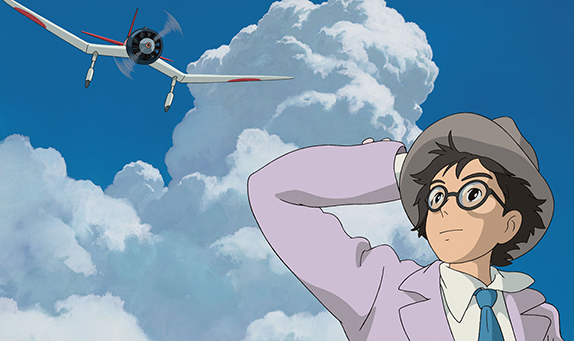
Author's note:
In 1941, How Green Was My Valley won best picture over Citizen Kane. I haven't seen Disney's Frozen, which recently won an Oscar for best full-length animated feature, but feel sure The Wind Rises is much better.
In The Wind Rises, anime master Hayao Miyazaki adds his own memories and obsessions to the real life of Jiro Horikoshi and the writings of Tatsuo Hori. The result is a complex film of great beauty, one that has angered the right wing in Japan for its attitude toward 1930s militarism, and disappointed others worldwide for its failure to show the consequences of the hero’s quest.
Jiro Horikoshi designed the innovative Zero, a long-range and highly maneuverable fighter used in the attack on Pearl Harbor. Once the United States had caught up in fighter design, the Zero became a manned missile. Late in World War II hundreds of Allied ships were attacked, and scores sunk, by kamikaze pilots.
Miyazaki chooses to focus on the life of the individual in a changing society. He paints an exceptionally detailed picture of Japanese society between the two world wars. This is a Japan that is not yet fully industrialized, where horse-drawn carts and pedestrians fill the unpaved streets and steam-powered ships are outnumbered on the waterways by sailboats. Middle and upper-middle class men and women may wear western dress during the day, but change into traditional clothing at home, a home that may be entirely Japanese in design or entirely western.
Jiro Horikoshi is first shown as an appealing boy who depends on thick glasses to correct his vision. He knows his poor eyesight will prevent him from becoming a pilot, but he dreams constantly of airplanes. One is wonderfully avian, with blue feather-like wingtips and a pink tail; others are warplanes carrying pulsating bombs tended by malevolent figures. In his dreams, Jiro meets the Italian airplane designer Caproni, who assures him that he needn’t be a pilot to become an aeronautical engineer.
In an instant, Jiro’s life course is set. He will design airplanes —“beautiful dreams.”
On the train on his way to study engineering in Tokyo, Jiro meets a young girl named Naoko. Both speak French and both know Paul Valery’s poem, “Graveyard by the Sea.” They quote to each other the lines that are the film’s epigraph,
“The wind is rising!,” says Naoko.
“We must try to live,” replies Jiro.
An earthquake interrupts their train journey as they approach Tokyo. In an extraordinary sequence, Miyazaki shows the Great Kanto Earthquake of 1923 as it moves from sea to city, demolishing buildings and causing a conflagration.
Jiro aids Naoko’s injured servant, using his slide rule as a splint for her broken ankle, then carrying her to safety on his back as pieces of burning paper and charred ash float down. At one point, Jiro looks up into the roiling clouds of smoke and sees in his mind’s eye warplanes, a foreshadowing of things to come as are the images of Tokyo reduced to rubble. In 1945, Tokyo was firebombed, leveling 19 square miles and killing over 100,000 people.
The earthquake sequence draws on Miyazaki’s life experiences and his preference on film for modeling good behavior rather than showing bad. During World War II, Hayao Miyazaki’s father managed Miyazaki Airplane, which was owned by his brother. It made parts for the Zero. Miyazaki’s family was evacuated to the city of Utsonimaya where they led a privileged life. When Miyazaki was four-and-a-half years old, Utsonimaya was fire bombed. He awoke to a room filled with pink light. His mother and siblings made their way out of town with their neighbors, his mother carrying Hayao’s younger brother on her back. They were rescued by Miyazaki’s uncle, who had barely managed to save his truck from the flames. Miyazaki’s family climbed into the truck and drove off as a neighbor implored, “Please take us with you.” Miyazaki never forgot that night.
Once Jiro’s schooling is complete, he becomes an aeronautical engineer at Mitsubishi. Japan is in an economic depression, with failing banks, large numbers of unemployed, and neglected children on the streets. At Mitsubishi, the pressure is on to design warplanes to be used against, who knows—America? Meanwhile, the men play baseball on their breaks and oxen pull the prototype planes to the airfield.
Jiro’s drafting table is shown again and again, the paper covered with sketches, formulas and calculations in pencil. These frames suggest Miyazaki’s own preference for the hand-drawn rather than the computer-generated. Nothing in The Wind Rises is computer-generated. The gorgeous watercolor landscapes and cloudscapes were hand-drawn and painted, as were the hundreds of buildings, scores of interiors, dozens of airplanes, scores of character-filled faces. Miyazaki also focuses repeatedly on Jiro’s slide rule. Perhaps because one has to approximate in order to arrive at the correct answer with a slide rule. If to draw is to see, to calculate with a slide rule is to think.
Years after their encounter on the train, Jiro and Naoko meet again in a resort in the mountains. They are brought together by the wind. The wind is a presence in the film. It ruffles Jiro’s tousled hair and Naoko’s summer dresses, ripples the water in a stream, the grasses in a meadow, the leaves on the branches. It unfurls flags and fills the windsocks at the airfields. It does what it will, beyond anyone’s control. The wind is the force of history. When Japan was saved from a Mongol invasion in the 13th century by a typhoon, the typhoon was described as a “spirit” or “divine” wind, that is, kamikaze. In 1930s Japan, it is clear that the wind is rising.
At the mountain resort, a German guest tells Jiro that the Nazis are a “gang of hoodlums” and that the great airplane manufacturer Hugo Junkers has run afoul of Hitler. He goes on to speak negatively of Japan’s attacks on China and Manchuria. The German is subsequently followed by Japanese secret police, as is Jiro. This, and the earlier expression of pacifist sentiments, is what seems to have bothered the Japanese right wing.
Jiro and Naoko quickly fall in love, a romance drawn from Tatsuo Hori’s 1938 short story, “The Wind Has Risen,” which has the same epigraph as the film. Naoko has tuberculosis, as did the female character in Hori’s short story and Miyazaki’s mother, who was bedridden for eight years. Jiro and Naoko’s devotion and displays of affection are highly unusual for a Miyazaki film. They indicate the importance given to the bond between them, one that sustains them and cannot be broken.
Near the end of the film Jiro says, “All I wanted to do was design beautiful planes, ” but his beautiful planes were also killing machines. How they killed and whom they killed is not shown. It appears Miyazaki believes an individual should not feel guilt for the ways his talents are used. This is not a problem most of us have to face. But here in New Mexico, one thinks of Robert Oppenheimer at the detonation of the first A-bomb repeating lines from the Bhagavad Gita, “Now I am become Death, destroyer of Worlds.” And as Robert McNamara pointed out in The Fog of War, if the Japanese had won, Americans would have been charged with war crimes for the firebombing of 62 Japanese cities with napalm.
So, what are individuals to do when the wind rises? Fight back? Disappear? It seems Miyazaki believes we should recognize that we are powerless against the winds of history. We are to work to fulfill our dreams, to behave decently, to love deeply—to try to live, while the tempest rages.



Responses to “The Wind Rises: Miyazaki’s Most Personal Film”